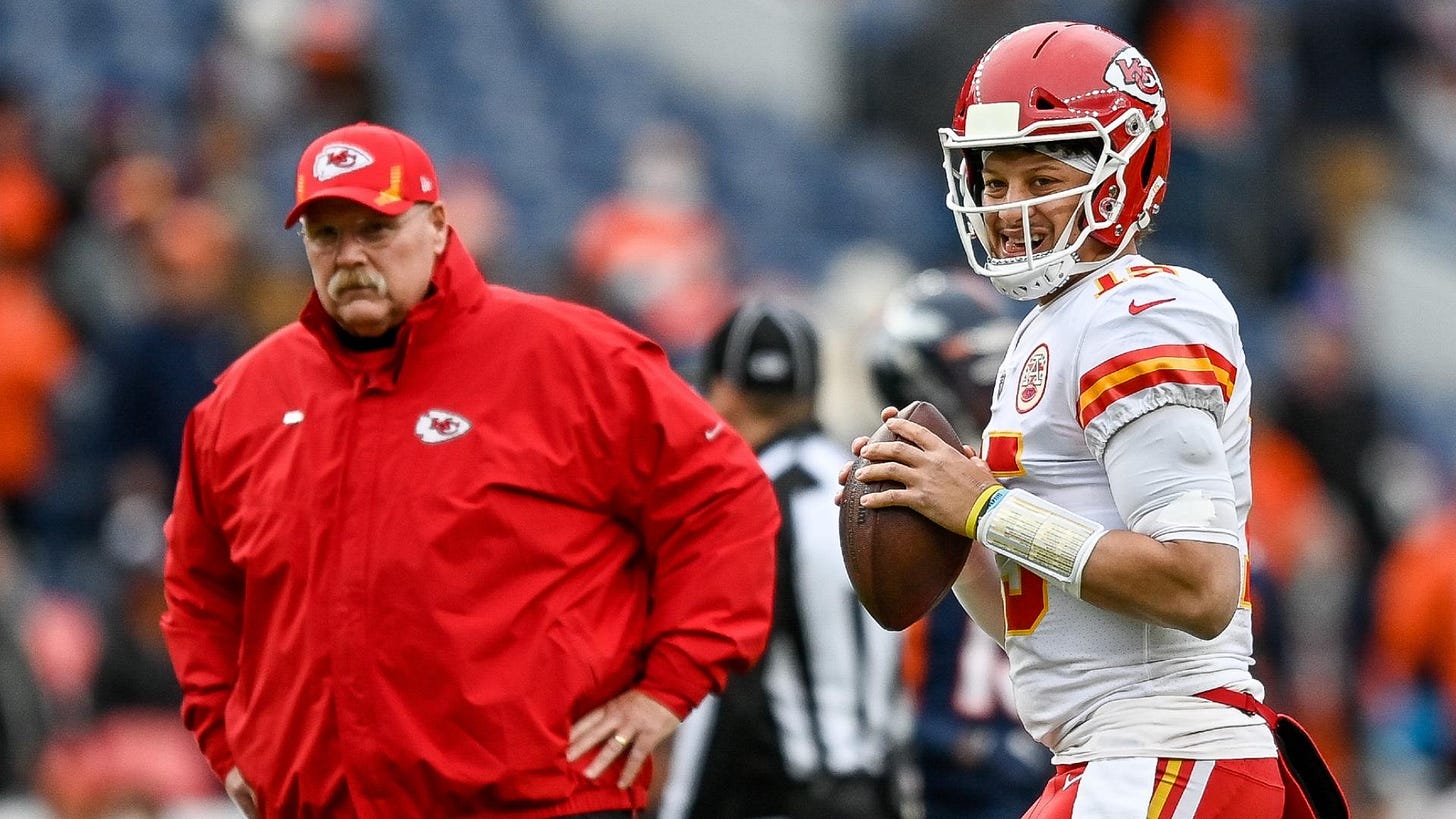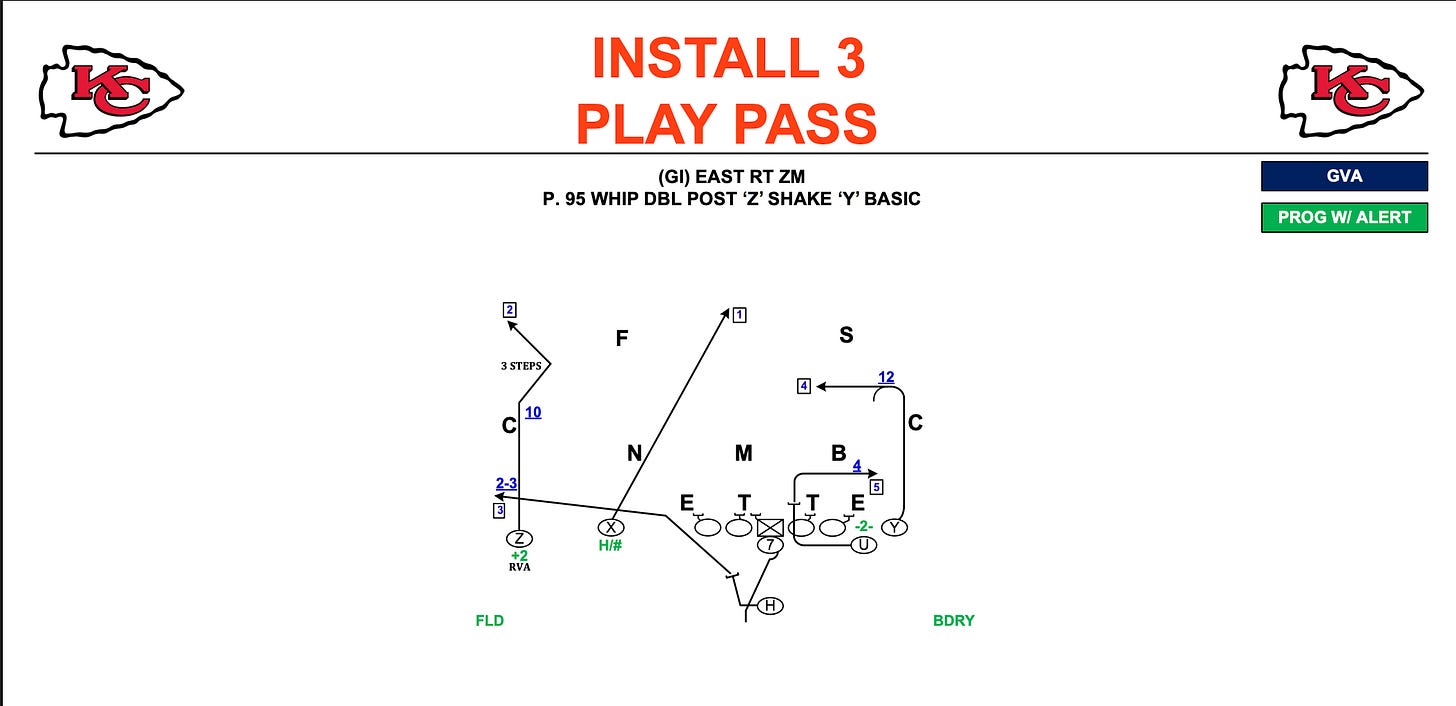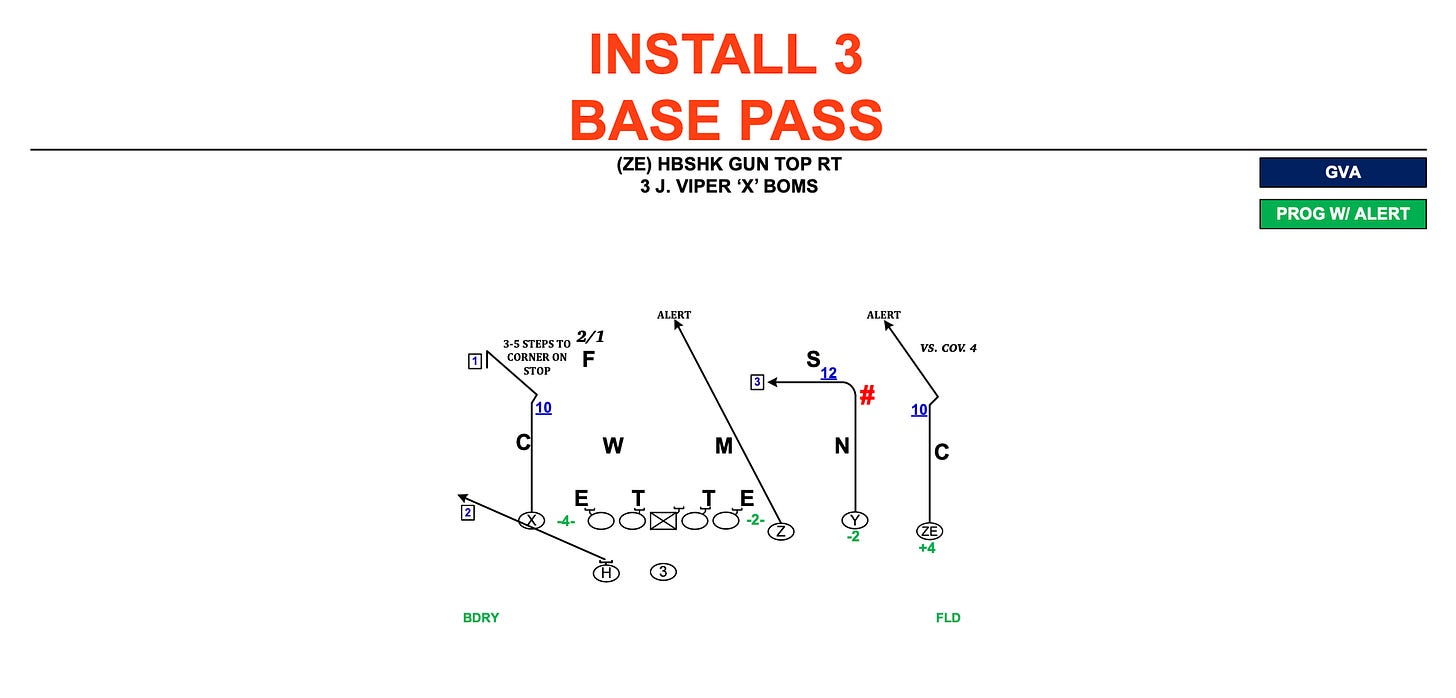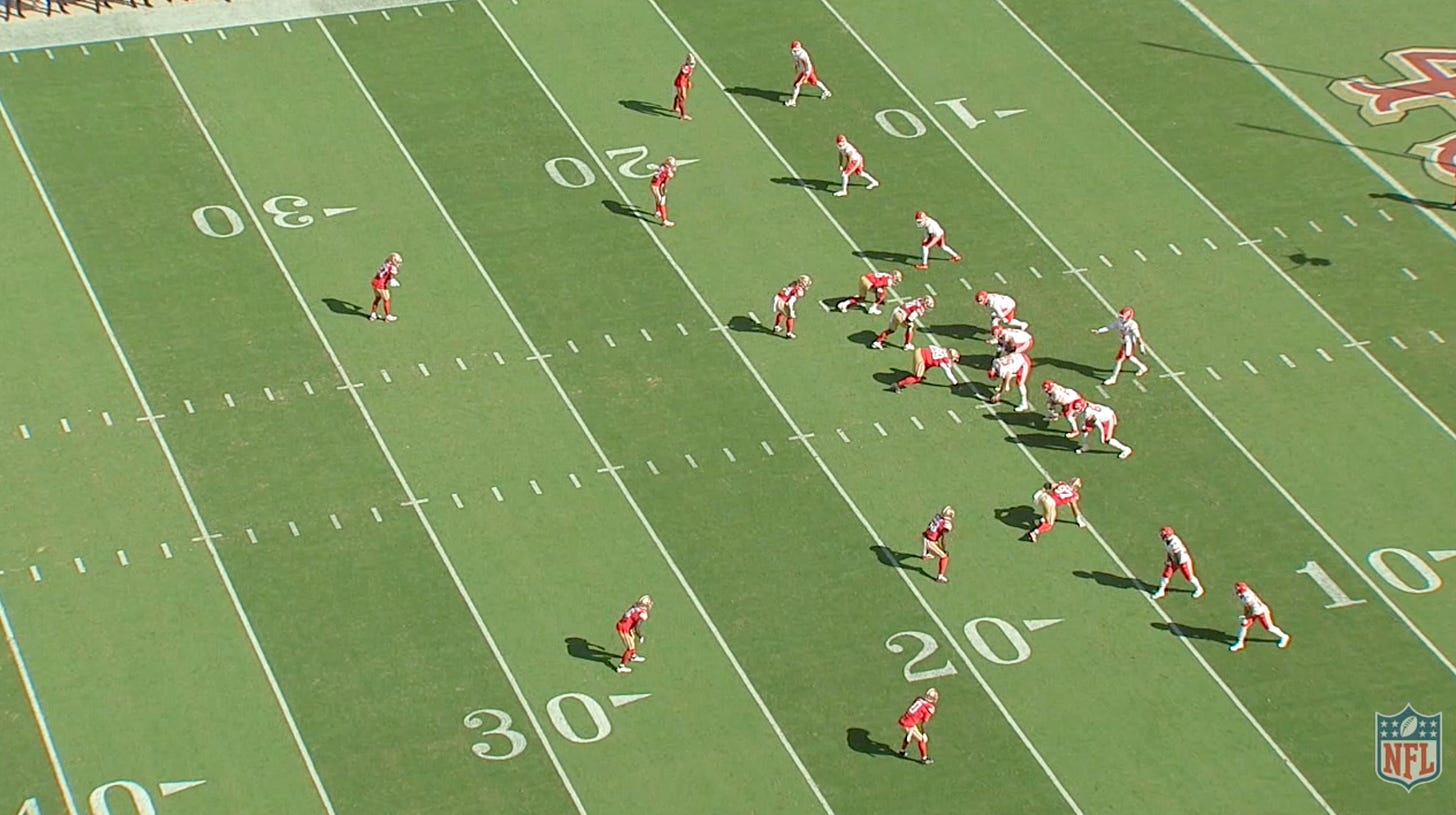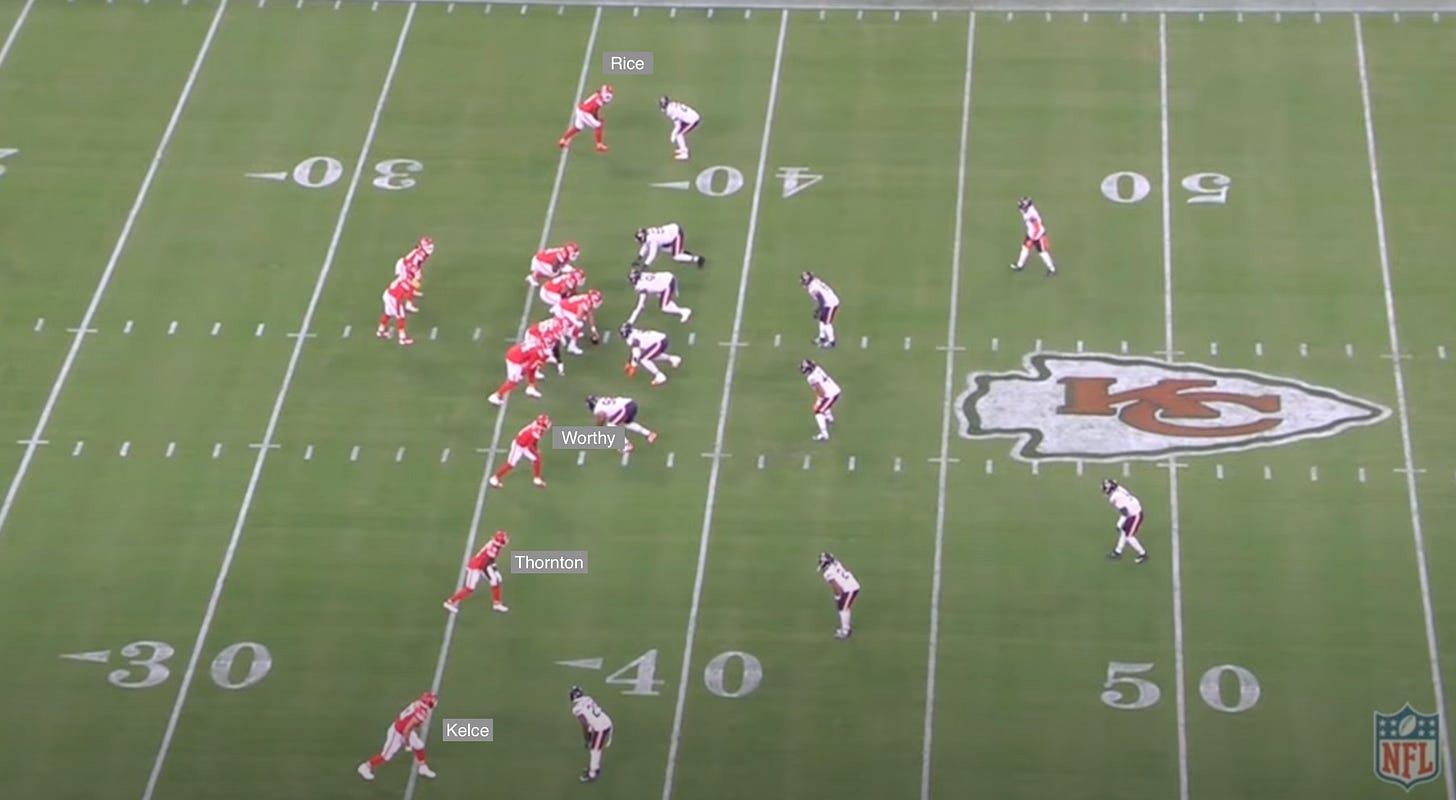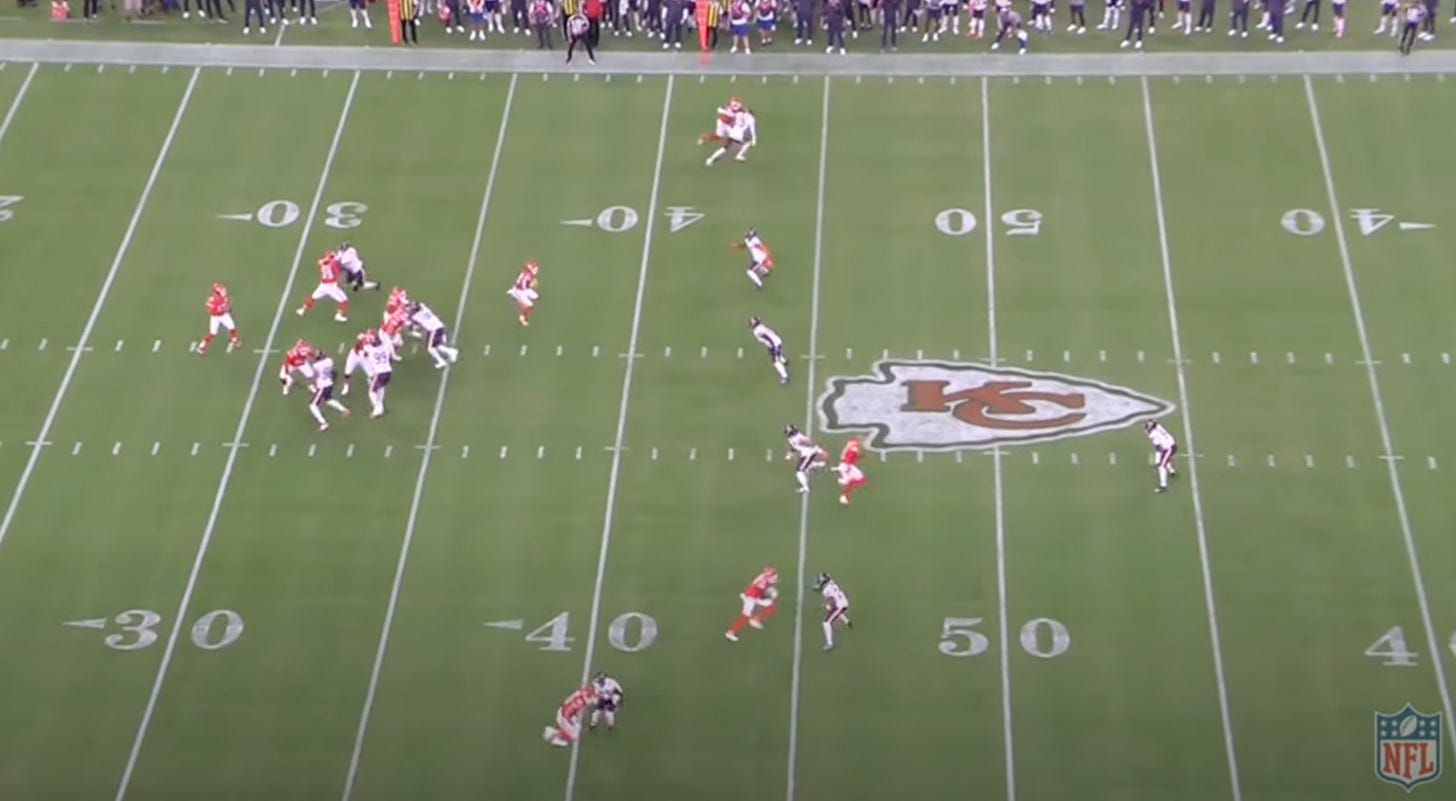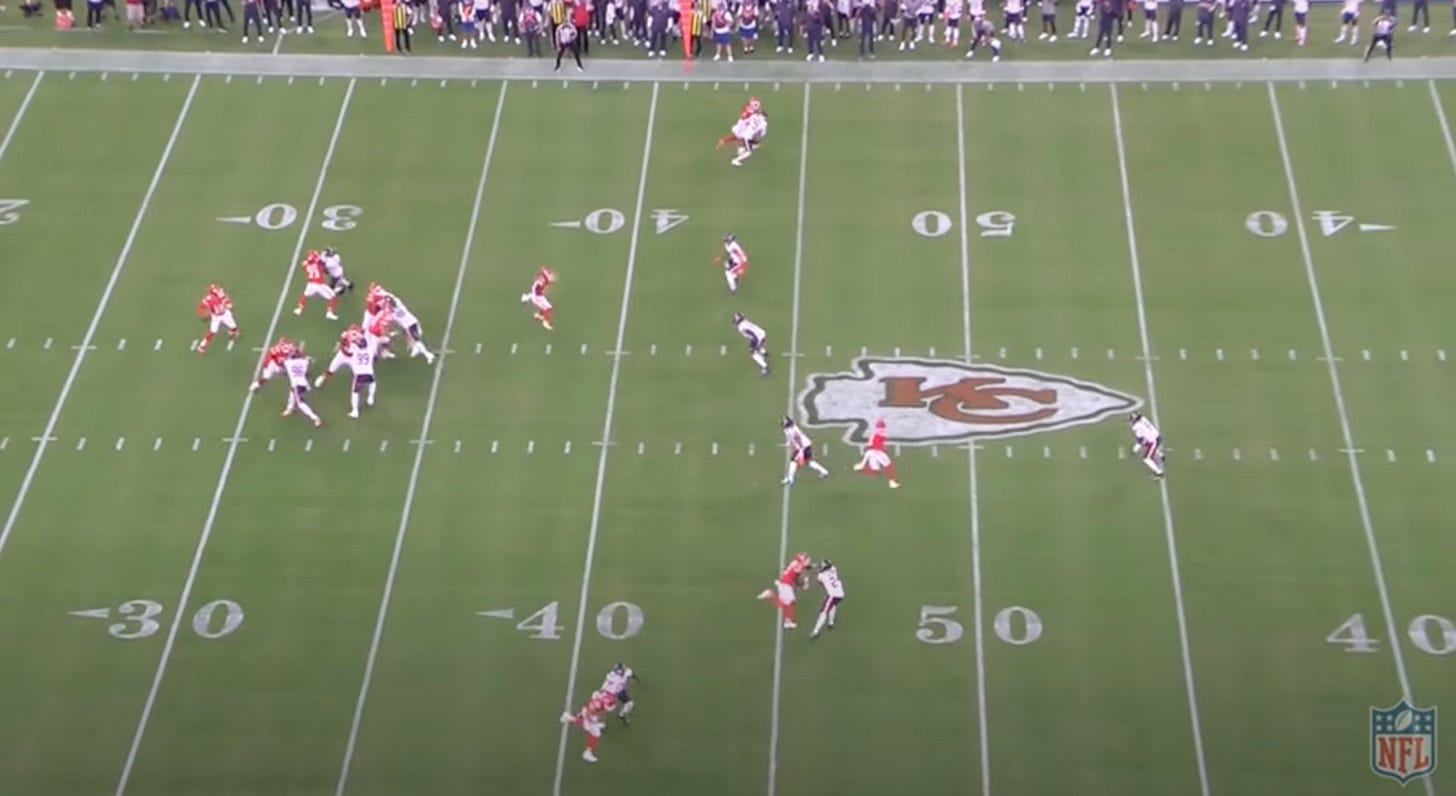The re-orientation of the Chiefs' offense
Can Andy Reid and Patrick Mahomes rediscover their sizzle?
Even in the course of watching hundreds of games that bleed into one another, certain random possessions stick out in your mind.
There I was, idly watching Dennis Allen’s Bears, when I saw this:
Behold: your new-look Kansas City Chiefs.
I know, I know. It’s preseason. Everyone is running vanilla schemes. Game plans are built to evaluate a team’s own players, not punish the opposition. It’s all meaningless. Blah, blah, blah. Still, you leapt out of your chair, right?
If you’re looking for a snapshot of what the Chiefs’ offense could look like this year, there you have it. It cuts (a little) against the grain of the Andy Reid–Patrick Mahomes partnership. Even in the Chiefs’ heyday – with a youthful Travis Kelce and a flying Tyreek Hill – the Chiefs rarely shuffled Kelce out to the boundary. They were not an isolation offense, relying on a single star to tilt coverage or win one-on-one matchups. They won through play design, throttling zone coverage, and springing their superstars open with Reid’s classic man-beater concepts — or, you know, having Mahomes spin magic out of nothing.
The Chiefs would shuffle Kelce and Hill around the formation, funk with matchups, mess with defensive rules, and then trigger explosive plays thanks to the structure of the offense. It was, in a way, its own form of the multi-progression system that Aaron Rodgers mastered in Green Bay; a way to pair Reid’s west-coast ideals, the precision of his offense, with Mahomes’ off-script work.
Isolation work didn’t come into it, unless it was Mahomes receiving a pre-snap signal that told him where to go with the ball immediately at the snap (and he does as much damage with that as anyone in the league). It was matchup ball – Brady-like, frankly – but not ISO ball, where the routes are often independent of one another and you’re hoping two or three receivers can win one-on-one. It’s a subtle but distinct difference.
When Reid did adopt some ISO work, it was built around Kelce. He ripped stuff from the glory days of Sean Payton and Jimmy Graham, so-called Y-ISO packages that put Kelce (a “Y” tight end) on one side of the formation and the other receiving threats on the opposite side. But there was a difference there, too. Kelce would be placed in an exaggerated split on one side of the formation, ostensibly working as a decoy, or he would be tight to the formation, where he could feast against zone looks. One was a third-down design to free grass up for Hill. The other was an early-down easy button.
But that flash against the Bears in preseason is something different. It’s spicy. It’s downright mean. Reid rolled out one of his vintage 3x1 sets, only with Kelce moved from his traditional role in the slot to the perimeter. Ordinarily, when the Chiefs split Kelce out as a receiver, it’s either to put him in the slot or to the #2 spot, with a speedster on his outside shoulder to help press back the coverage and create a void that he can attack.
That makes sense. Kelce isn’t running by anybody these days. And the good ol’ times of having Graham or Gronkowski move to the boundary and defenses responding by kicking a linebacker out there are long gone. Defenses have adjusted.
When Kelce has been flexed to the perimeter in recent years, it’s been from empty sets, with Kelce used as an escape valve, slicing underneath. He was part of the progression, but working as the checkdown.
In the preseason, Reid showed a new strand of ISO ball.
Here, Kelce is playing as a boundary receiver, matched up against a corner. From there, Reid gets to have his fun. To one side, he isolates Rashee Rice. To the other, Kelce is the outermost receiver. Inside him is Tyquan Thornton, a free-agent cast-off the Chiefs picked up this offseason. Inside him, nestled in the slot, is Xavier Worthy.
The pre-snap presentation gives Mahomes a dose of old-school ISO ball. And it’s telling that Rice is the isolated guy. Few players have undergone such a personality transplant (*cough* on the field *cough*) as Rice. At SMU, Rice played above the rim. He was a vertical guy who lollygagged off the line and then exploded in the air to grab anything in sight beyond 15 yards. In the pros, he’s been an underneath player who can also threaten the intermediate portion of the field. In Kansas City, he’s become a kind of YAC merchant, a chain-mover. He’s a piece in the puzzle, not given star treatment by his own staff or treated as such by defenses.
By putting Rice in an ISO spot, the Chiefs are screaming: We think this guy can be an every-level threat. Against any defender, in any coverage. In other words, he’s not a good receiver; he’s a superstar. That matters, even with Rice set to miss the first six weeks of the season with a suspension; the Chiefs are playing for January, not October.
Back to the design. The structure offers Mahomes a clear picture pre-snap without needing any motion or movement. The Chiefs move before the snap at the highest rate in the league, allowing Mahomes to gather as much intel as possible to attack immediately. Here, they gather that intel through formation, rather than movement.
To the ISO side, it’s Rice. If Mahomes likes the matchup, he can take the one-on-one shot. If not, he can work the concept the other way. But here’s where Kelce’s positioning becomes interesting. Because it’s not really about Kelce at all; it’s about the two speed demons inside.
According to NFL Next Gen Stats, Worthy and Thornton clocked the two highest speeds in the preseason. Putting that speed on the field with Mahomes is enough to get the juices flowing. But their usage is just as interesting. There they are, standing together, balanced between the Chiefs’ two most dangerous threats. For any defense, it’s a structural nightmare. Do you play to depth, backing up your safeties to ensure neither deep threat can get behind? Do you play up and tight, knowing you could get clipped over the head, but that you can probably beat these dudes up in press coverage?
The default answer is to roll into zone, and to have one safety pick up the slot once they declare their route. But against that kind of speed, that’s easier to draw up on the whiteboard than play in reality. Speed causes defenders to panic, lose their technique, and corrupt their leverage. And nobody punishes those hiccups like Mahomes.
At the snap, it’s game on. The Bears roll into a three-deep match coverage, which plays out as man coverage. That’s an immediate signal to Mahomes to pick his side: does he fancy taking the one-on-one shot or working the concept?
Keep your eyes peeled on the concept side. Look how it plays out. Look at how quickly Worthy and Thornton get going. They are downfield in a blink. When an offense has that amount of speed off the snap, every defensive decision is sped up by a fatal half-second. As the Bears’ safety rolls, he wants to reroute Worthy, bumping him to disrupt his path while funneling the receiver to his help. But he only gets a light nick. And as Worthy – literally the fastest player on the field – springs out of his break and towards grass, the deep safety is flat-footed.
Through formation and design, Reid has conjured three plus matchups: Rice on a one-on-one shot; Worthy against a flat-footed safety; Thornton in a straight foot race against a nickel corner. Thornton may not be many things, but he is blazingly fast. The Bears end up with Nick McCloud covering Thornton. In a straight sprint, that’s ordinarily a plus. McCloud is a 4.3 runner… but Thornton just so happens to be a 4.2 guy. Thornton’s speed destabilizes McCloud. He abandons his technique as Thornton closes, leaping out to try to stick something on the receiver before he goes flying past his earhole.
Everywhere Mahomes looks, there are opportunities. The price? Washing Kelce out of the play. By putting Kelce into the boundary, the tight end was essentially neutered for a rep. But through formation, the Chiefs forced the Bears to commit a corner on the soon-to-be Hall of Famer, freeing up a chance at an explosive on either side of the field – Rice streaking vertically or Worthy rolling into a void between the linebackers and deep safety.
Mahomes chose to work the ISO side. He chucked one up for Rice and drew a penalty. On reflection, he probably wished he had worked the concept, getting the ball to Worthy with a runaway opportunity in the middle of the field. Regardless, by formation and design, it worked. Pairing Worthy and Thornton together as inside receivers, despite any flaws they have as true receivers, is a nice way to break down a defense’s rules. Add a legitimate weapon outside those two, and it’s nightmare fuel.
Andy Reid is the greatest to do it in the modern era. He has a sense for where the sport is going, how defenses are adjusting, and races to the natural endpoint before others have entered first gear. But if he has one magic trick as an offensive designer, game plan builder, and play-caller, it’s this: he understands defensive rules. Reid has a way of keying on a defense’s adjustments, of knowing their checks against certain formations or pre-snap movements. Reid’s offense moves so damn much, but not for all the obvious reasons (overwhelming the point of attack, stealing leverage, getting a coverage indicator). Instead, he wants to force the defense into its checks. Reid internalizes defensive rules, moves his pieces to get a defense to play to those rules, and then unfurls a design built to break those rules apart.
Meaning: Say you respond to a certain motion or formation with a quarters check, then Reid will dial up his quarters beater from that formation with a motion tag. Once Mahomes spies the check, he knows it’s on. It sounds simple. It’s not.
Part of the reason Reid’s fourth-quarter EPA/play figures have held so steady throughout his career (with Mahomes and without) is that he’s the league’s chief code-cracker. He forces teams to change how they play certain looks on the fly, or to wholesale shift rules within a week, which leads to inevitable breakdowns on game day. If you adjust in-game or show something different from previous weeks, he latches on early and then breaks you down when he needs it later on.
Messing with the alignment of Kelce shifts the defensive rules at the best of times. Pairing Kelce with the combined speed of Worthy and Thornton is enough to give even the best sleepless nights, even with Rice missing time.
It seems like one meaningless preseason play. But it puts on film something the Chiefs have yapped about all offseason: they need to be more explosive.
Keep reading with a 7-day free trial
Subscribe to The Read Optional to keep reading this post and get 7 days of free access to the full post archives.


